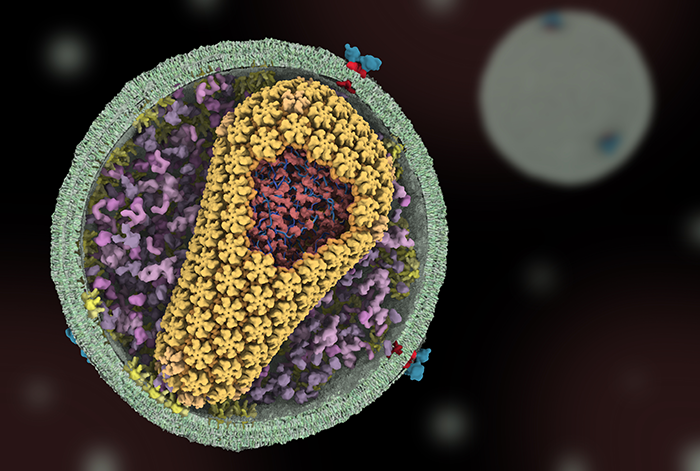Salk Institute researchers, in collaboration with National Institutes of Health (NIH) scientists, have discovered the molecular mechanisms by which human immunodeficiency virus (HIV) becomes resistant to dolutegravir (DTG), an integrase (IN) strand transfer inhibitor (INSTI) that is one of the most effective clinically used antiviral treatments for HIV infection.
The newly reported study, which used techniques including cryo-electron microscopy (cryo-EM) to evaluate drug binding in variants of HIV with mutant integrase enzyme, revealed how changes to the 3D structures of integrase can lead to dolutegravir resistance, and indicated how other compounds may be able to overcome this resistance.
“With HIV, one must think two steps ahead of the virus,” said Salk Associate professor Dmitry Lyumkis, PhD, the Hearst Foundation Developmental Chair and co-senior author of the team’s published paper in Science Advances. “We’ve now determined how the virus could continue evolving against drugs like dolutegravir, which is important to consider for the development of future therapeutics.” Lyumkis and colleagues described their findings in a paper titled “Mechanisms of HIV-1 integrase resistance to dolutegravir and potent inhibition of drug-resistant variants.” In their paper the team concluded, “Collectively, these data provide mechanistic insights into both drug resistance and its subversion and will enable more direct pathways to designing INSTIs with improved resistance profiles.”
HIV infection depends on the ability of the virus to paste its own genetic material into the genomes of human cells, essentially hijacking the cells to become virus-producing factories. Dolutegravir and related drugs work by blocking the viral enzyme integrase, which is critical to the ability of the virus to integrate its own DNA into the host genome. Part of this process of viral integration occurs in structures known as intasomes. “The formation of intasome species and the intasome-mediated insertion of the viral DNA (vDNA) into the host genome are essential steps in tihe viral replication cycle,” the authors wrote. Without functioning integrase HIV can’t effectively infect human cells. However, HIV is a rapidly mutating virus, and an increasing number of HIV strains are resistant to dolutegravir.
The Lyumkis’ lab had previously reported on the 3D structure of the integrase protein while attached to DNA, and discovered exactly how drugs like dolutegravir bind to and block integrase. But researchers still weren’t sure how the integrase structure changed when the virus stopped responding to dolutegravir. In the newly reported study, Lyumkis and NIH collaborators created versions of the integrase protein with combinations of mutations (E138K, G140A/S and Q148H/K/R) that were known to make HIV resistant to dolutegravir. Then they determined the structure of each mutant integrase, using cryo-EM technology to show the structures of drug-resistant HIV-1 intasomes bound to DTG, and revealing why dolutegravir could no longer block versions of the protein with these drug resistant mutations (DRMs). “Our efforts to understand the effects of the mutations E138K + G140A/S + Q148H/K/R revealed specific weaknesses in the ability of DTG to inhibit certain complex DRMs … These structures, complemented with free energy simulations, virology, and enzymology, explain the mechanisms of DTG resistance involving E138K + G140A/S + Q148H/K/R and show why 4d maintains potency better than DTG.” Lyumkis added, “We were quite surprised by the magnitude of resistance that these integrase variants had. The ability of Dolutegravir to function was completely compromised.”
They also evaluated the “fitness” of the virus (its capacity to produce infectious descendants) and the activity of the enzyme to better understand what leads to drug resistance in patients.
The researchers separately tested the efficacy of an experimental HIV drug, 4d, to block the function of dolutegravir-resistant integrase proteins. 4d was developed by Lyumkis’ collaborators at the NIH as a next-generation integrase-targeting drug, and is currently in preclinical testing. In the study just released, and in all the variants, 4d still potently blocked the ability of HIV to integrate its genes into human cells. This suggests that 4d or variants of this compound may be effectively used to treat the virus in patients who have developed resistance to dolutegravir.
The structural data on how 4d binds to the dolutegravir-resistant integrase proteins also hinted at how new drugs could overcome drug resistance. “4d is really just an example of how to combat drug resistance, but it provides us with some basic principles that we can learn from to design other therapeutics,” said co-senior author Robert Craigie, PhD, at the National Institute of Diabetes and Digestive and Kidney Diseases (NIDDK). “The way a section of the 4d molecule stacks like a flat sheet on top of a section of the integrase protein-DNA assembly could be replicated in other compounds.” The authors further noted, “… adenine stacking onto 4d is a contributing factor to the increased potency of 4d as compared with DTG and should be considered in future design strategies to optimize INSTI binding to DRM intasomes … although stacking is not the only contributor to potency, it appears to be an important one.”
![From left: Tim Strutzenberg, Zelin Shan, Dmitry Lyumkis, Dario Passos, and Avik Biswas. [Salk Institute]](https://www.genengnews.com/wp-content/uploads/2023/07/low-res-13-300x200.jpeg)
Next, the scientists will study how integrase variants evolve—including those not yet seen in patients but possible in the future—and how they impact response to the best clinically used drugs as well as the ability of HIV to infect humans. They further noted, “One of our objectives is to understand why certain compounds, such as 4d, perform better than the clinically approved drugs against key DRMs. Multidisciplinary analyses, which include structure, biochemistry, virology, and computation, should help dissect the principles that lead to efficacy of some compounds but not others.”
This level of understanding would be an important step in the design of new INSTIs that offer broad potency, and the underlying principles applied to other drug targets. And commenting on their newly reported data, the team stated “Together, the structures and the simulations provide a framework for understanding, at an atomic level, the changes that are observed in the mutations within the E138K/G140A/Q148K pathway when DTG is bound.”


